Special Feature: Products Sally Recommends
Première Bordeaux — J'arrive
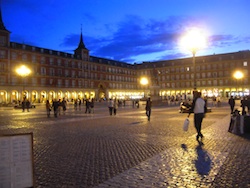 Madrid was a delightful city to behold, with a blend of modern architecture and old world structures in its heart, combined with the vibrancy of the youthful Spaniards. The town never slept. Our trek “across the pond” took its toll on my weary bones, more so than my last European adventure. I was determined to endure, so as not to become a burden. Assisted by my son and his friend Fede, a day and a half was put into that town that most would not experience in several. Yet quickly the first phase of my whirlwind Madrid tour was over, and I encountered the sleepless anticipation of an early morning departure for Bordeaux. My hotel was a Best Western, sandwiched in between Madrid’s two major airport terminal clusters for convenience. Mindful of the morning’s departure schedule, I relied on a sleeping pill to combat the awakening anticipation.
Madrid was a delightful city to behold, with a blend of modern architecture and old world structures in its heart, combined with the vibrancy of the youthful Spaniards. The town never slept. Our trek “across the pond” took its toll on my weary bones, more so than my last European adventure. I was determined to endure, so as not to become a burden. Assisted by my son and his friend Fede, a day and a half was put into that town that most would not experience in several. Yet quickly the first phase of my whirlwind Madrid tour was over, and I encountered the sleepless anticipation of an early morning departure for Bordeaux. My hotel was a Best Western, sandwiched in between Madrid’s two major airport terminal clusters for convenience. Mindful of the morning’s departure schedule, I relied on a sleeping pill to combat the awakening anticipation.
I was at the front desk of the hotel, with bags packed, earlier than its first scheduled shuttle pick-up. Not knowing how difficult it would be for me to figure out the modern Terminal 4 departure procedure, early arrival was deemed necessary. Of course, the airport was relatively empty. Obviously no one else shared my same sense of urgency. The flight took a little over an hour, but it seemed a full day had passed by 10:15 am. when the plane touched down. I read several reviews of the Bordeaux airport over the internet, many of which were not complimentary. To me the place seemed like a very efficient small airport, easily navigated even if your French was as rusty as mine. The car rental stations were inside the terminal, and the cars were a convenient walk outside to access.
I loaded up into a brand new 4 door Peugeot and crossed my fingers as my Garmin GPS device was mounted to the windshield. As it came on, the map appeared with my location accurately shown. A sigh of relief was exhaled, accompanied by a quick “sign of the cross.” With no trouble at all, I was on the way to my hotel, only minutes away. Fortunately, the Comfort Hotel had a room available where I could drop off my luggage and proceed into my planned GPS navigation tests, before departing for my first winery visit scheduled for 3:30 pm. that afternoon.
First I sought the closest gasoline station. This became my initial exposure to the infinite number of round-abouts, mentioned in my Forward. Ms. Garmin took me to a place, just on the inside of the City-skirting Loop, called Carrefour, where there were indeed a number of gasoline pumps with people lined-up for their turn at what appeared to be a relatively inexpensive price for fuel (1.60 Euros per liter, which translated to $8.82 per gallon). Equally amazing was the massive store, adjacent to these pumps. Curiosity mandated further inspection. Walking through the automatic doors unveiled a huge slice of American influence, which had no doubt changed the lives of everyone in France. It was the likes of Wal-Mart or Target, with people swarming all around as if they were bees in a hive. You want it, they’ve got it… So, just like in the USA, the “mère et père” retailers were no-doubt getting squeezed out of existence. Throughout the trip, I noticed numerous Carrefour Markets, even near the small winery villages of Pauillac and Pomerol. With an ample dose of roadway mania already under my belt, I purchased the French version of a deli sandwich (laced with butter) and returned to the hotel for a rest.
Two o’clock’s alarm jolted me awake, and the true test of my navigational system was about to commence. Arrival there would be by means of the first “global coordinates” programmed into my Garmin device. My first winery visit was in the Pessac-Leognan region (south of the City). The appointment was at Smith-Haut-Lafitte, awarded the Grand Cru Class in 1959. I had noted the high Robert Parker ratings of their red and white Bordeaux blends in my study of the region.
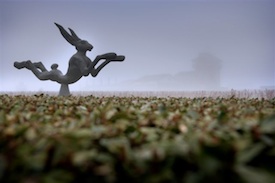 Daniel and Florence Cathiard, both French Olympic downhill snow-skiing team members back in the 1960’s (during the days of Jean-Claude Killy), had purchased this distressed and neglected vineyard property with proceeds from selling their sporting goods retail interests in 1990. With hard work and dedication, they brought it back into prominence in the Bordeaux wine scene since that time. Florence, consummate marketing guru (after learning of my writing for some American publication), had offered to meet with me for an aperitif in her private office, following my tour of the facilities. The thought of this opportunity was thrilling.
Daniel and Florence Cathiard, both French Olympic downhill snow-skiing team members back in the 1960’s (during the days of Jean-Claude Killy), had purchased this distressed and neglected vineyard property with proceeds from selling their sporting goods retail interests in 1990. With hard work and dedication, they brought it back into prominence in the Bordeaux wine scene since that time. Florence, consummate marketing guru (after learning of my writing for some American publication), had offered to meet with me for an aperitif in her private office, following my tour of the facilities. The thought of this opportunity was thrilling.
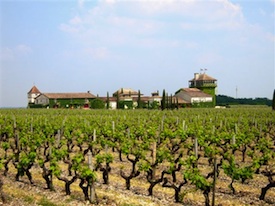 I knew the general direction of travel, and my GPS verbal directives were taking me that way, so I started to feel more comfortable. Within 10 minutes of exiting the City’s loop road to the south, there was a diversion off of the main thoroughfare and into some rural neighborhoods. It seemed strange, because I had envisioned expansive vineyards all the way there. Remarkably, the surroundings looked like I was traveling through a stretch of the east-Texas piney-woods. Then, as residences faded away, clearings ahead showcased newly sprouting rows of grape vines. The look was unlike that of Napa, in that the vine support-wires were only a couple of feet off the ground, with rows only about a meter apart. Soon I would learn that such was the norm throughout all of Bordeaux.
I knew the general direction of travel, and my GPS verbal directives were taking me that way, so I started to feel more comfortable. Within 10 minutes of exiting the City’s loop road to the south, there was a diversion off of the main thoroughfare and into some rural neighborhoods. It seemed strange, because I had envisioned expansive vineyards all the way there. Remarkably, the surroundings looked like I was traveling through a stretch of the east-Texas piney-woods. Then, as residences faded away, clearings ahead showcased newly sprouting rows of grape vines. The look was unlike that of Napa, in that the vine support-wires were only a couple of feet off the ground, with rows only about a meter apart. Soon I would learn that such was the norm throughout all of Bordeaux.
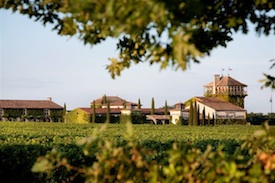 My heart fluttered as I beheld my first view of an actual Bordeaux Chateau. The grounds of the Smith-Haut-Lafitte winery complex were right out in the midst of these vineyards. Planted, they had 67 hectares (2.471 acres =1 hectare), 56 of which were in Cabernet, Merlot, Cabernet Franc and Petit Verdot, 11 in Sauvignon Blanc, Sauvignon Gris and Semillon. It was a lovely sight.
My heart fluttered as I beheld my first view of an actual Bordeaux Chateau. The grounds of the Smith-Haut-Lafitte winery complex were right out in the midst of these vineyards. Planted, they had 67 hectares (2.471 acres =1 hectare), 56 of which were in Cabernet, Merlot, Cabernet Franc and Petit Verdot, 11 in Sauvignon Blanc, Sauvignon Gris and Semillon. It was a lovely sight.
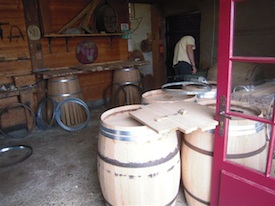 Profoundly early, I decided to walk around and take some pictures of these wonders. There were some tour groups already being shown around by one of the female hosts. I started thinking that my tour would be the same, much like a Napa visit. Nosing around one corner of the compound, I noticed a rustic workshop which reminded me of a blacksmith’s quarters in the old West. In fact, it was their in-house Cooper (Jean Luc), making wine storage barrels out of straight slats of oak. From that point onward, this visit was going to be special. Jean Luc noticed me, smiled and continued to work, sanding the outside of a barrel on the spinning lathe in front of him. Taking a break, he spoke to me in French and then broken English. Yet with my sparse understanding of his language, we managed to communicate the important points. He showed me the process by which the straight planks were heated and bent into the curves of a barrel shape, then how the metal bands are applied. Most interesting was the gas-fired tube projection out of the floor of his shop, over which new units are placed and ignited for internal “toasting.” The aroma was memorable. By then, I could have walked away from the winery contented… and yet my visit had not officially started.
Profoundly early, I decided to walk around and take some pictures of these wonders. There were some tour groups already being shown around by one of the female hosts. I started thinking that my tour would be the same, much like a Napa visit. Nosing around one corner of the compound, I noticed a rustic workshop which reminded me of a blacksmith’s quarters in the old West. In fact, it was their in-house Cooper (Jean Luc), making wine storage barrels out of straight slats of oak. From that point onward, this visit was going to be special. Jean Luc noticed me, smiled and continued to work, sanding the outside of a barrel on the spinning lathe in front of him. Taking a break, he spoke to me in French and then broken English. Yet with my sparse understanding of his language, we managed to communicate the important points. He showed me the process by which the straight planks were heated and bent into the curves of a barrel shape, then how the metal bands are applied. Most interesting was the gas-fired tube projection out of the floor of his shop, over which new units are placed and ignited for internal “toasting.” The aroma was memorable. By then, I could have walked away from the winery contented… and yet my visit had not officially started.
Time came for my appointment, so I walked up to the room where the others had assembled. It was soon obvious that it was just going to be me on this tour. One of the hosts came out and asked if I was Mr. Rusciano. After my nodding yes, she asked me to wait while she summoned Mrs. Cathiard from her private chambers. She was to personally guide me through the facility. Sheer delight reigned. Yet, minutes later she returned and apologized profoundly, because Mrs. Cathiard was on a promotional conference call with someone (much more important) named “DuPont.” Of course there was disappointment, but I understood completely. She summoned one of their winemakers named Yann to escort me through the property and answer my questions. His command of English was very good, and thus we experienced infrequent communicational impasses.
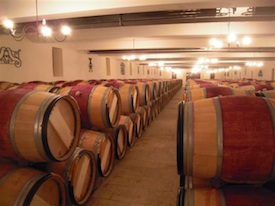 We traveled through the wine making equipment and I received a complete explanation of the processes they utilized (not unlike previous experiences in Napa). We visited the barrel storage rooms, where the 2010 red was being aged and the 2009 was being “racked” (process of filtering out sediment before bottling). Bottling of the ‘09 was just about to commence, in less than a month. I noticed the stained center sections of the barrels, similar to those in many California wineries to camouflage accidental wine drips during sampling and racking. Yet, I needed an explanation about the curious double wooden bands secured to each end of every barrel they possessed. Enlightenment about the first of many Bordeaux traditions came with his explanation. Back in the days of old, when wine storage caves were dank, unkempt places, small strips of chestnut branches were wrapped around the ends of barrels, bound tightly with wicker wrappings. Natural chemical properties in these bands would keep spiders and other harmful bugs away from the barrels. Today’s wine storage chambers are pristine and bug free, yet the tradition lives on. (BTW, throughout the entire trip, only one establishment had eliminated these bands from their barrels.) “Gimme that ole-timed religion…”
We traveled through the wine making equipment and I received a complete explanation of the processes they utilized (not unlike previous experiences in Napa). We visited the barrel storage rooms, where the 2010 red was being aged and the 2009 was being “racked” (process of filtering out sediment before bottling). Bottling of the ‘09 was just about to commence, in less than a month. I noticed the stained center sections of the barrels, similar to those in many California wineries to camouflage accidental wine drips during sampling and racking. Yet, I needed an explanation about the curious double wooden bands secured to each end of every barrel they possessed. Enlightenment about the first of many Bordeaux traditions came with his explanation. Back in the days of old, when wine storage caves were dank, unkempt places, small strips of chestnut branches were wrapped around the ends of barrels, bound tightly with wicker wrappings. Natural chemical properties in these bands would keep spiders and other harmful bugs away from the barrels. Today’s wine storage chambers are pristine and bug free, yet the tradition lives on. (BTW, throughout the entire trip, only one establishment had eliminated these bands from their barrels.) “Gimme that ole-timed religion…”
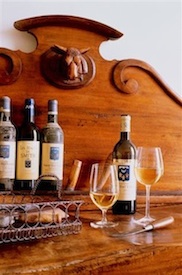 Smith-Haut-Lafitte typically produces around 50 thousand bottles of white Bordeaux and 150 thousand of red each year. Yann informed me that they blend their reds from barrels, 80% of which are aged in new oak and the balance have been used once before. As a treat, he allowed me my first barrel taste of the 2010 vintage. The wine was youthful, yes, but obviously its intensity and richness were going to make it a wonderful compliment to its highly rated sister from the year before.
Smith-Haut-Lafitte typically produces around 50 thousand bottles of white Bordeaux and 150 thousand of red each year. Yann informed me that they blend their reds from barrels, 80% of which are aged in new oak and the balance have been used once before. As a treat, he allowed me my first barrel taste of the 2010 vintage. The wine was youthful, yes, but obviously its intensity and richness were going to make it a wonderful compliment to its highly rated sister from the year before.
We proceeded to the place where the Cooper was making barrels, and my previous meeting with Jean Luc was acknowledged. Thus there was no need for a full explanation again. We continued onward to a formal banquet hall, where tables were outfitted for tasting. I was to sample the 2007 white and red. I had never tasted white Bordeaux before, and the experience was superior to any of the California Sauvignon Blanc creations previously sampled. Their three grapes blend must have made the difference. The red was a medium-bodied, silky wine, with a smooth tannin structure, ready for consumption. It is not the bold monster that the 2010 will be, but I could recognize the quality that the Cathiards had achieved in their stewardship of this property.
The greatest thrill of the afternoon was just about to unfold. With my eye for construction, I noticed that the dark stained timbers of the flooring in this wonderful hall were running the length of the room. Yet, there were fine lines cut across several pieces which did not match with a random plank installation. Something mysterious was hidden beneath. Yann noticed my curiosity. He looked around to see if the “coast was clear” and then asked me to assist him in relocating the items of furniture which were resting over the top of the spot. With everything out of the way, I could see it was a doorway to some secret chamber. He went into another room, and there was the sound of a switch flipping, followed by the groaning noise of an electric motor system opening up the two leaves to this subfloor hideaway. The floor/door panels halted when they were vertical to the floor’s surface. Then automatically, tiny dim lights appeared, illuminating the wooden plank stairway down into the most splendid “man-cave” I have ever seen. We slowly descended in to this modern-day cellar, lined with wooden cased, recessed wine storage coves and a back-lit projection screen which took up the entire end wall. Pictures to set the mood of any event could be illuminated in life-sized fashion. This was the Cathiards’ private stash of old vintages produced during their ownership of the winery. There may have been other premium Bordeaux bottles down there, but there was no way to make a survey since it was too dark for me to read all the labels, without “readers.” I admired the lovely tables and sitting area where their friends can “hang-out,” enjoying the “fruits” of the estate. Later I slapped myself for not taking pictures in this wonderful cavern, but the excitement-of-the-moment literally overwhelmed me. Fortunately, Florence was kind enough to forward some photos by email at the time this piece was composed. The tasting room and the cave were constructed only three years ago, yet neither were detectable as new construction. This was an incredible addition, without a doubt.
At the conclusion of my visit, I slowly drove away in awe of this beautiful vineyard and winery. How could there be anything out there which could top this fascinating experience? The trip back was laden with Bordeaux traffic, but it went virtually unnoticed. I navigated my way to my first and only French restaurant visited on this trip. The food was an exquisite fish dish, but sparse. The price for it was uncomfortably expensive. The wine consumed with it, although not a notable label, was tasty Bordeaux. I was (of course) all alone in the restaurant, since the regulars did not arrive until much later in the evening. Bedtime was early, because my first visit of the next morning was in Margaux, and there was no way to know how long it would take to drive there. I was yet unaware of just how much more excitement was awaiting.
Best Western Hotel Villa de Barajas
Garmin GPS
Comfort Hotel
Carrefour Markets
Smith-Haut-Lafitte
Note: This information was accurate when it was published. Please be sure to confirm all rates and details directly with the businesses in question before making your plans.



